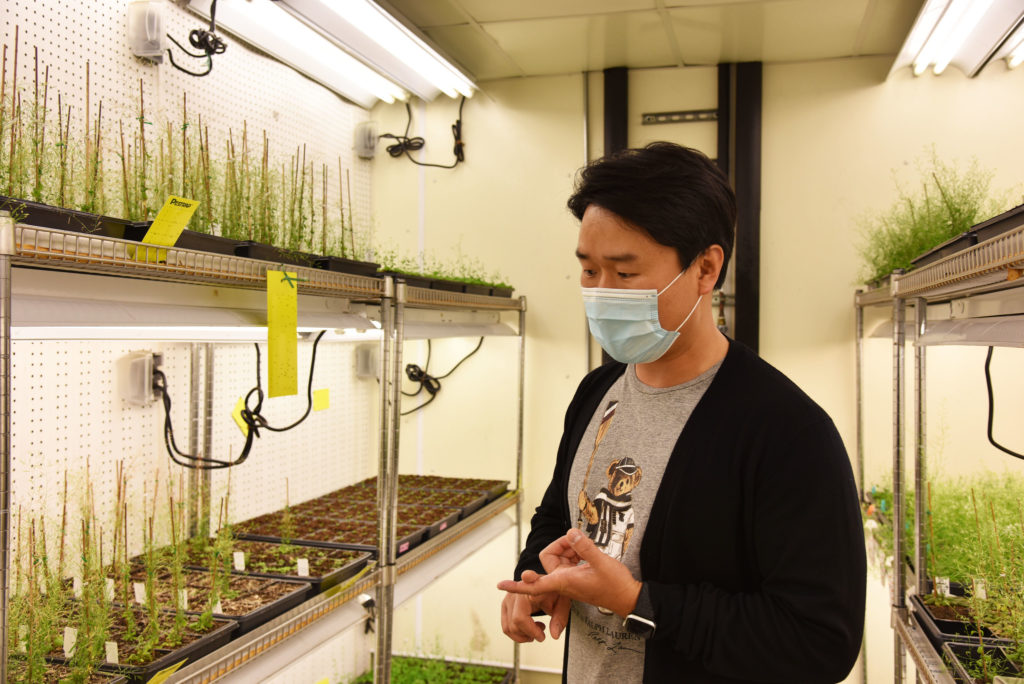
Sung-Hwan Cho, a research scientist in the Gary Stacey lab, checks in on the Arabidopsis plants that he uses in his purinergic signaling experiments. | photo by Lauren Hines, Bond LSC.
By Lauren Hines | Bond LSC
Until the 1990s, the presence and significance of extracellular ATP, a nucleotide that normally provides energy to a cell, in animal cells was highly contested for decades. Now, the Gary Stacey lab at Bond Life Sciences Center is using that history lesson to explore ATP’s role in plant cells.
Let’s say you have $100 in your pocket. As you’re walking down the street, you throw dollar bills over your shoulder. Sounds ridiculous, right?
Much like these dollar bills, ATP is the currency of cells. When the idea of animal cells dispensing ATP outside the cell to trigger danger signals came out in the 1970s, the scientific community thought it was wasteful and therefore the idea was ridiculed.
“The idea of throwing money over your shoulder is a very good analogy because that’s a good way to influence people,” said Stacey, a principal investigator at Bond LSC. “Give them a financial incentive. It’s the same thing with ATP. The idea is that this is the currency of the cell, but they’re putting it outside the cell in order to signal and influence interactions with their environment or other cells.”
This process of ATP receptors on the cellular membrane bonding with molecules to send signals and communicate between cells is called purinergic signaling.
The term was coined by retired neurobiologist Geoffrey Burnstock in the 1970s when he discovered it in animals; however, Burnstock’s findings were met with skepticism. It wasn’t until 20 years later when the first ATP receptor in animal cells was discovered that his idea gained acceptance.
Today, animal cell purinergic signaling has been used to make drugs that target diseases and develop drug therapies. As for purinergic signaling in plant cells, the research is just beginning. Much like what Burnstock faced, this new research is met with skepticism.
“It was clear to me that if we really wanted to establish this so that people would believe it, we had to get the receptor,” Stacey said.
In 2014, the Stacey lab reported its first ATP receptor called P2K1. Earlier this year, they found another one called P2K2.
“I think more and more people are working on purinergic signaling in plants,” Stacey said. “I think we will see a big explosion of people working in this area. Just as is the case with the animal field, the plant field is really going to take off now that we actually know what the receptors are.”
Currently, the Stacey lab is trying to understand how these receptors work. Research scientist Sung-Hwan Cho from the Stacey lab took over the project regarding P2K1.
“The ATP study in animals is just half a piece of the puzzle,” Cho said. “You need to find the other half of the piece. For 40 years, many labs have already studied this, but in plants, there’s just been a few.”
Research done by the Stacey lab has shown that although not much is known about purinergic signaling in plants compared to in animals, purinergic signaling can impact plant growth, development, defense against diseases and stress tolerance. Cho is currently studying how P2K1 impacts certain metabolic pathways in plants.
In another experiment done by the lab, they found that mutants without the ATP receptor that experienced stress did not grow smaller while plants that did have the receptor and experienced stress grew smaller.
“That says the purinergic signaling is what’s mediating the stress response,” Stacey said. “That is affecting the development of the plant in response to stress… So, if we understand this better then maybe we can make plants that are more drought and stress-tolerant and grow better.”
Original post available at: https://decodingscience.missouri.edu/2020/10/26/learning-from-history/

